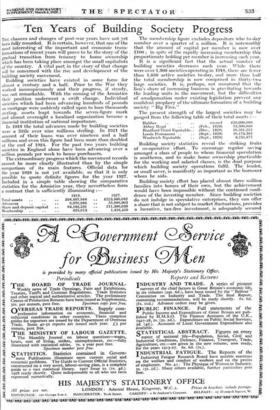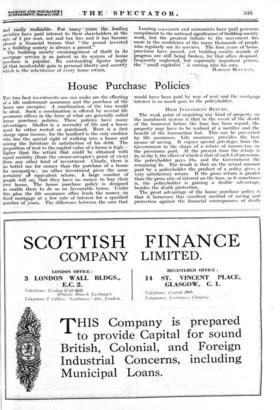Ten Years of Building Society Progress THE chances and changes
of post-war years have not yet been fully recorded. It is certain, however, that one of the most interesting of the important and economic trans- formations of recent years will prove to be the story of the , gradual transition from tenancy to hothe ownership which has been taking place amongst the small capitalists of the country. A vital part, in the story of that change will be concerned with the rise and • develcilmnent of the building society movement.
Building societies have existed in some form for almost a century and a half. Prior to the War they worked inconspicuously and their progress, if steady, was not remarkable. With the coming of the Armistice their position underwent a swift change. Individual societies which had been advancing hundreds of pounds on mortgage were suddenly called upon to loan thousands sterling, assets leapt towards the seven-figure mark and almost overnight a localized organization became a financial institution of national importance.
In 1918 the total advances made -by building societies were a little over nine millions sterling. In 1921 the amount of their loans was over nineteen and a half millions and even this figure had been more than doubled. at the end of 1924. For the past two years building societies in England alone have been advancing over a million pounds per week to house purchasers. The extraordinary progress which the movement records cannot be more clearly illustrated than by the simple comparison of its main features. Official data for the year 1928 is not yet available, so that it is only possible to quote definite figures for the year 1927. Included in a simple table showing the .comparative statistics for the Armistice year, they nevertheless form , a contrast that is sufficiently illuminating :— Total assets .. 1918.
£68,497,948 .. 1927.
£223,346,082 Advances 6,970,986 55,886,903 Share and deposit capital .. 64,185,531 211,386,036 Membership . 625,013 1,416,456 The membership figure excludes depositors who to-day number over a quarter of a million. It is noteworthy that the amount of capital per member is now over £100 ; in spite of the rapidly increasing membership this proportionate holding per member is increasing each year. It is a significant fact that the actual number of building societies decreases each year. While there were over 1,300 societies operating in 1918, there are fewer than 1,050 active societies to-day, and more than half the total membership is now comprised in thirty-two large societies. It is, perhaps, not unnatural that the lion's share of increasing business is gravitating towards the leading units in, the movement, but the difficulties of amalgimation under existing legislation prevent any confident prophecy of the'ultimate formation of a building society " Big Five."
The present strength of the largest societies may be gauged from the following table of their total assets :- Halifax .. exceed £50,000,000 ' Abbey Road .. (Feb., 1929) 13,500,000 Bradford Third Equitable.. (Dec., 1928) 10,561,215 Leeds Permanent .. .. (Sept., 1928) 10,174,301 Woolwich Equitable .. (Sept., 1928) 8,235,877 Building society statistics reveal the striking fruits of co-operative effort. To encourage regular saving amongst a class of people to whom financial speculation is anathema and to make home ownership practicable for the working and salaried classes, is the dual purpose which building society operations fulfil. The lender, or small saver, is manifestly as important as the borrower whom he aids.
Building society effort has placed almost three million families into homes of their own, but the achievement would have been impossible without the continued confi- dence of the investing member. Since building societie§ do not indulge in speculative enterprises, they can offer a share that is not subject to market fluctuations, provides a lucrative, tax-free investment, is adequately secured and easily realizable. For many --years the "leading societies have paid interest to their shareholders at the rate of 5 per cent. net and tax free and it has become almost a financial truism that " the pound invested i in a building society is always a pound.' The building society encouragement of thrift in its mortgage • service is as patent as its system of house ':purchase is popular. Its outstanding figures imply 'all that incalculable gain in personal liberty and security which is .the inheritance of every home owner. Leading statesmen and economists have paid generous compliment to the national significance of building-society work, but the greatest tribute to the movement lies more in the confidence of the many thousands of pet)* who regularly use its services. The lean years of house provision have passed, yet building society records of progress are still being broken, for that often despised, frequently neglected, but supremely important person, the " small capitalist " is coming into his own.
HAROLD BELLM AN.,

























































 Previous page
Previous page